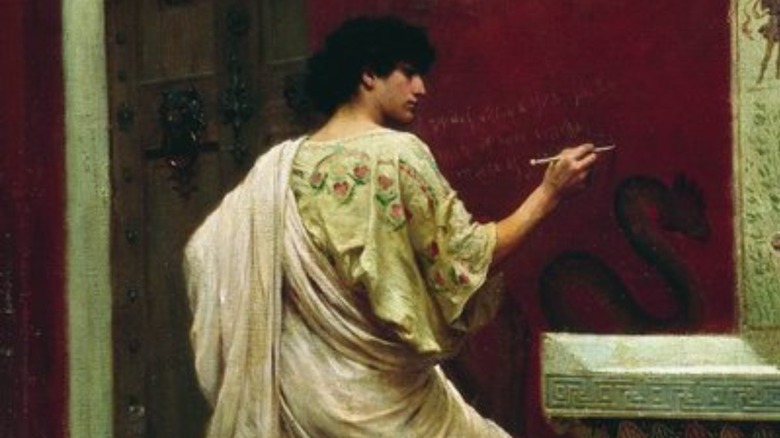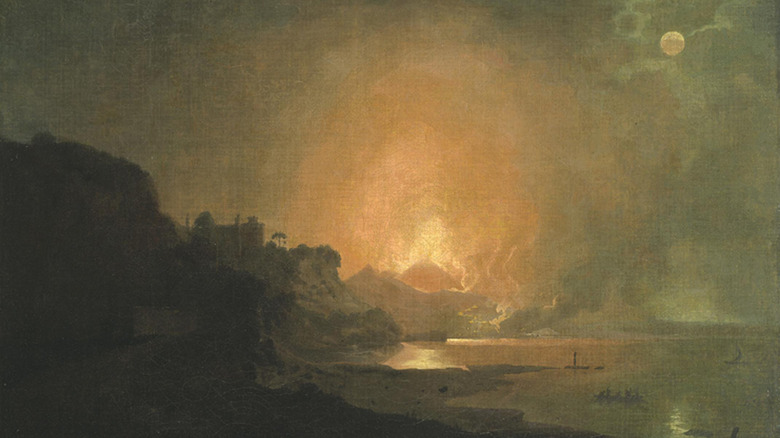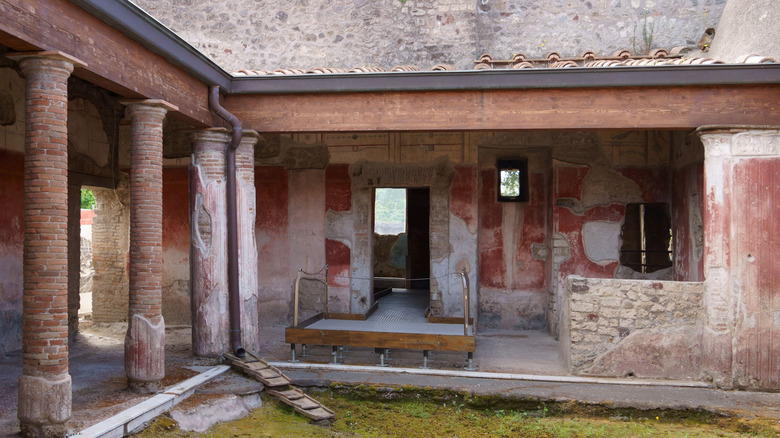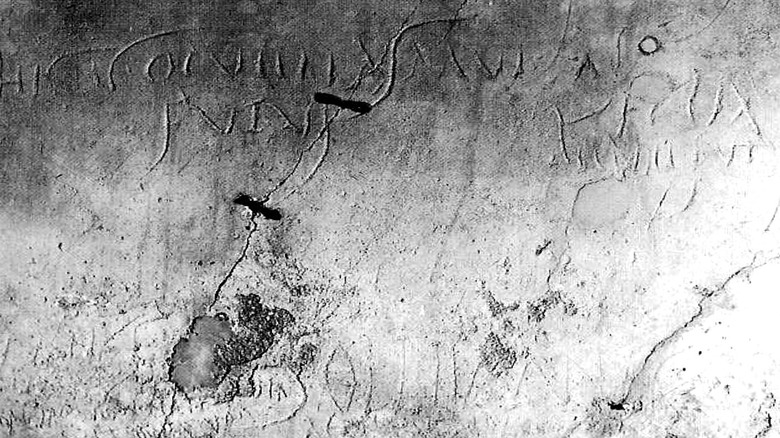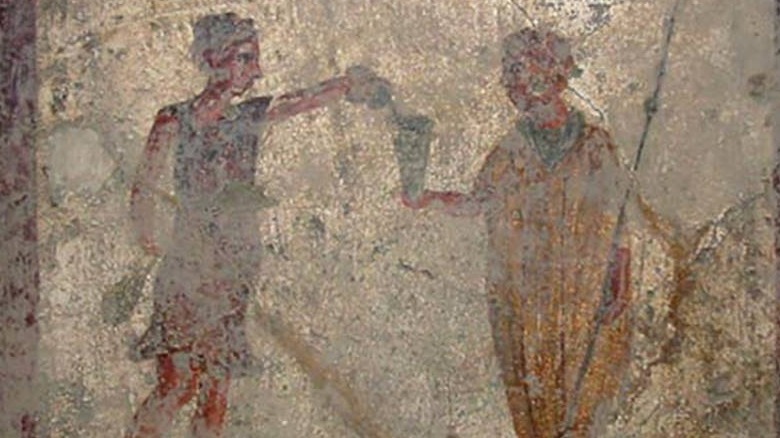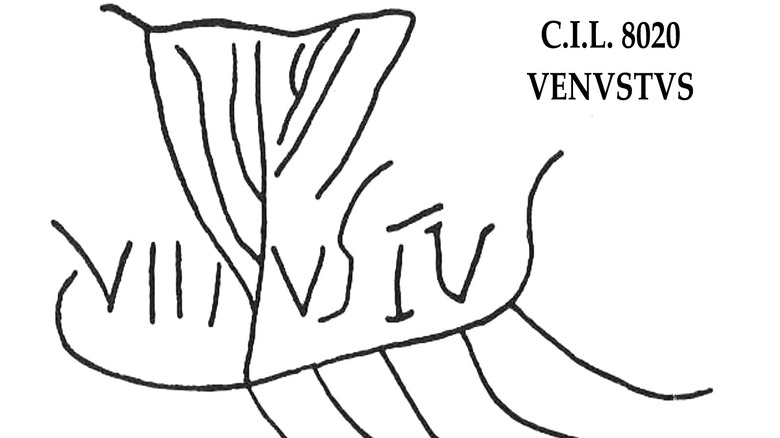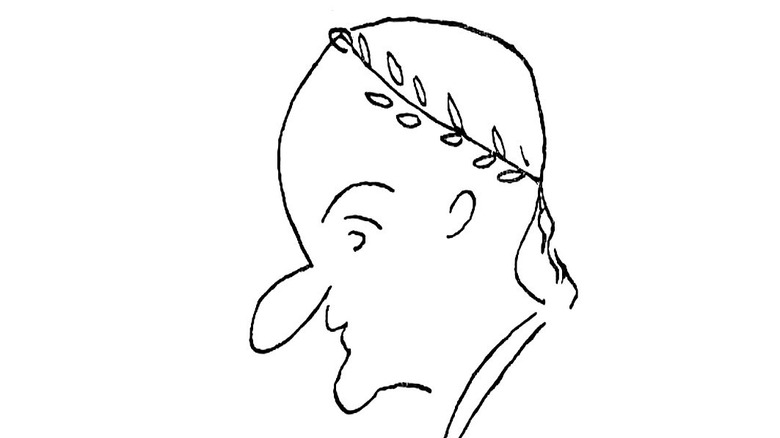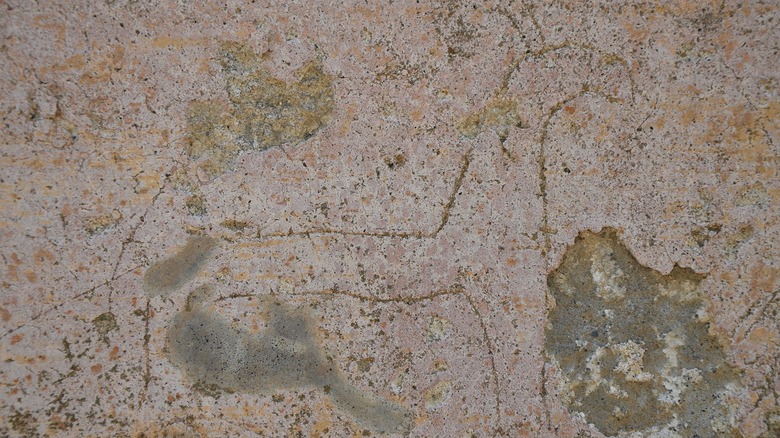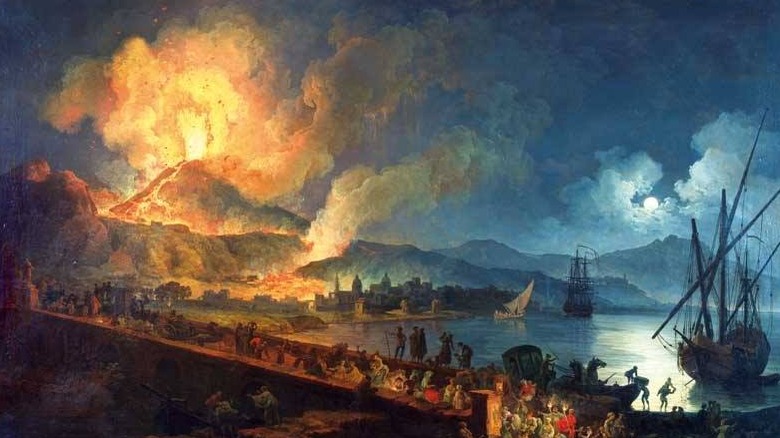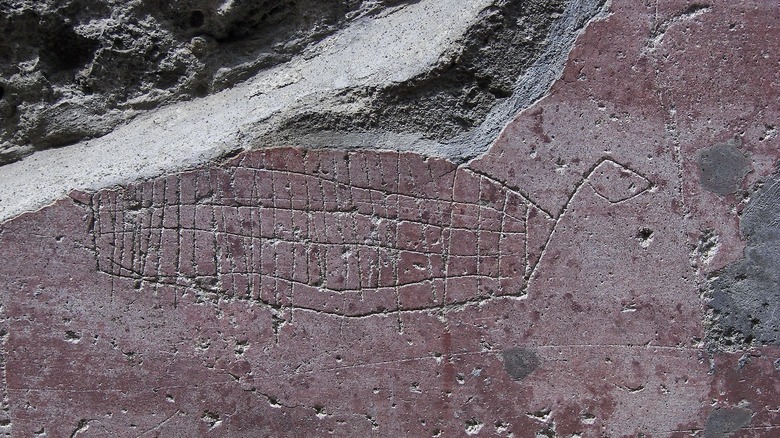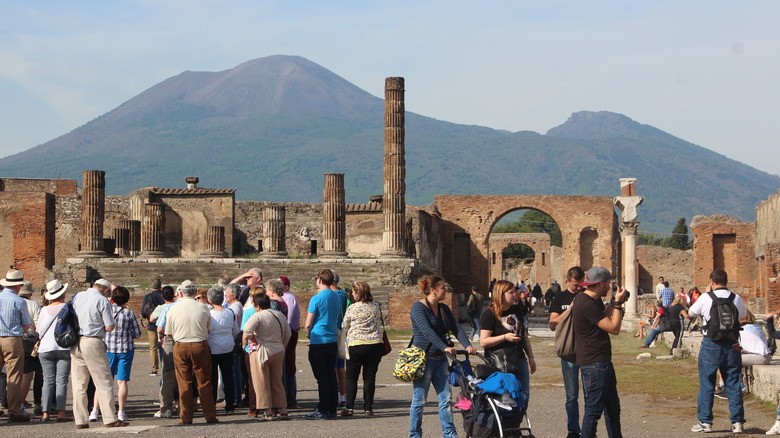The Surprising Graffiti Found At The Ruins Of Pompeii
Ask just about any modern city dweller, and they'll tell you that graffiti is little more than an eyesore. Who wants to look at walls tagged with someone's name, or stare down at yet another boring joke, crass insult, or sad-sack declaration of love in a bathroom stall?
It can all seem pretty inconsequential, but it's the little things that matter — to archaeologists, anyway. If our civilization were frozen in time and then uncovered centuries in the future, it's all but certain there would be at least a few graduate theses written about our graffiti, no matter how embarrassing the content. Yes, even the gross stuff. (In fact, the gross stuff would probably get the most attention.) Don't believe us? Then look to Pompeii.
We may think of the ancient Romans as a bunch of noble, boring classicists, but the truth is that they were messy and complicated people, just like we are today. Excavations in the city of Pompeii, buried beneath the debris from an A.D. 79 volcanic eruption, make that achingly clear. The humanity of Pompeii's citizens is on display everywhere, from the bread left in an oven by bakers as the ashes fell to the people whose remains were found by excavators more than a thousand years later. Ash and other debris from the eruption also preserved the city's graffiti, which ranges from angry, to lewd, to downright touching and everything in between. What archaeologists have found scratched onto the walls of Pompeii will surely surprise you.
Pompeii's graffiti was preserved by a devastating volcanic eruption
Graffiti is often seen as something that's pretty ephemeral. It's not as if its creators expect their work to last more than a few days, much less generations. They write that they were there or record some offense or half-remembered joke, and then they move on. It surely wasn't all that different for people in the ancient world. They were still people, after all, with thoughts, feelings, and drunken party antics that would probably feel familiar to quite a few of us.
But then there was the volcano. Mount Vesuvius, which loomed over Pompeii and nearby Herculaneum, erupted in A.D. 79, burying the towns in thick layers of ash. Those who were able to escape must have assumed that everything was destroyed. Hadn't they seen their towns obliterated by debris from the volcano, not to mention the superheated pyroclastic flows that swept over everything?
Except the ash was precisely what helped preserve so much of their town. Pompeii spent centuries entombed in the ash, until excavations revealed not only homes and human remains, but graffiti inscribed seemingly everywhere (via The Atlantic). If anyone woke up after a lively night and cringed at what they wrote in a latrine, they may not have been happy to know that the volcano didn't swipe it all away. For many Pompeians, their hasty words are now transcribed and, in some cases, even digitized for modern folks to ponder at their leisure.
Some of the ancient graffiti is surprisingly high-minded
Though graffiti has something of a low reputation nowadays, the breadth of what was written across Pompeii is surprisingly diverse. Sure, there are plenty of silly verses and remembrances in low-class spots, but there are also inscriptions found in finer places. According to Smithsonian Magazine, these can include greetings from friends scratched into the walls of their rich associates' houses, sometimes around finely painted frescoes that surely cost a fortune to commission. Even the richest, most spoiled residents succumbed to the graffiti urge — in other people's homes, anyway.
Other graffiti found in high-class villas in Pompeii included popular poems, sometimes transformed by the writer as they were making their mark in the home. Some people were more interested in the visual arts, using their time to scratch pictures of animals, people, or boats. This is in direct contradiction to the decidedly stuffy pronouncements of earlier archaeologists. They assured readers that it was only the scruffy lower classes who engaged in such defacement and that, of course, historians wouldn't be interested in their grubby exploits (via National Geographic). They were, it turns out, very wrong on multiple fronts. Now, a careful examination of the homes and neighborhoods frequented by Pompeii's aristos shows that they were just as likely to take a stylus to the walls as one of the common folk.
Some Pompeian graffiti gets seriously raunchy
Some of the graffiti excavated at Pompeii is downright touching, such as the inscription that reads: "Health to you, Victoria, and wherever you are may you sneeze sweetly." Hopefully, Victoria sneezed at some point and then thought fondly of her well-wisher. But, humans being what they are, all of the thoughtful or lovelorn stuff is balanced out by some seriously naughty messages scattered across Pompeii. These include a variety of rather blunt notes, including boasts about someone's relations with a barmaid and one man's lewd farewell to all women. He had seemingly given up on heterosexual pairings and wanted the rest of Pompeii to know all about it (via The Nation).
Other scraps of graffiti carry insults down through the millennia. Some of them aren't too crass, though they surely hurt feelings, like the inscription that calls someone "sheep-faced" or another one that points out a certain person's baldness. Another snobbishly deems someone to be a country bumpkin (via The Atlantic). Some even act as blunt reviews, telling anyone who passed by just what the writer thought about a place of business or its employees. Speaking to National Geographic, professor Rebecca Benefiel brought up an example of a tavern where an exterior wall was marked by one particularly damning review claiming the wine was watered down.
Graffiti upended long-held notions about Roman society
All too often, the only record we have of a society is what was written down by the well-educated upper classes. It makes sense, but that doesn't mean it's fair. Yet in Pompeii, the common folk directly told us about their lives by writing on the walls of their city. What's been uncovered since the ruins were found in the 16th century has progressively upended our assumptions about Roman society.
For instance, many previous historians and archaeologists assumed that neither slaves nor women in Rome were able to write. Yet, graffiti from a wide variety of people proves that quite a few Pompeians were literate. According to professor Rebecca Benefiel, who spoke to National Geographic, there are even examples of graffiti from female slaves. One, a woman named Methe, used graffiti to proclaim her love for Chrestus. Her inscription, scratched outside a theater in Pompeii, ends with "May Pompeian Venus be propitious in her heart to both and may these two always live harmoniously."
Benefiel also notes that previous archaeologists concluded that only the rabble was producing graffiti. Only, further excavation revealed graffiti everywhere, from sketchy alleys to richly appointed villas. One man even proclaimed via graffiti in neighboring Herculaneum that he was none other than Apollinaris, physician to the emperor. That wasn't all. Apollinaris further wrote on the side of a latrine that he had a particularly satisfying bowel movement in that very spot (via Ancient Graffiti Project).
Trends were a big part of making graffiti in Pompeii
If you think memes belong solely in the era of social media, think again. People have been following social and cultural trends for nearly all of recorded human history, and it's hardly shocking to imagine even prehistoric humans latching onto an absurd joke or image and sharing it with their friends in the next village. Looking at the graffiti found in Pompeii, the ancient Romans were no different. Sure, it's not exactly Nyan Cat or "Blorbo from my shows," but neither is it all that far off.
Per De Gruyter, some of the most prevalent sketches found throughout Pompeii were those that depicted gladiators or ships. Given the popularity of the aforementioned athletes and the city's proximity to a waterway (now known as the Gulf of Naples), that's not exactly shocking. But then it appears that people began writing names in the shape of a ship, a more distinct form of graffiti that popped up throughout Pompeii. Meanwhile, at least three men started a mini-trend of writing their names backward, as uncovered in one home.
Phrases went in and out of fashion, too. These included quotes from popular poetry, but also seemingly nonsense words like "Menedemerumenos." According to "A Companion to Terence," this could be a reference to a character in a popular comedy by Roman playwright Terence. However, it's not clear why the people of ancient Pompeii were scratching the name of a character on walls throughout the city.
Of course there were political ads
While some people were proclaiming their love or hate for their fellow humans via graffitti, and yet others were leaving bad reviews for subpar taverns, some folks couldn't resist the urge to air out their political opinions. And, not unlike what happens in politics today, the politicians themselves weren't above getting involved.
According to Scientific American, Pompeii was awash in political ads. Some were relatively simple affairs, stating that the candidate was a good person or could bake a really excellent loaf of bread. Others seem to have been put up by professional artists with more skill than your standard graffiti enthusiast. The vast majority were placed in major thoroughfares, but not on public buildings. Instead, researchers have found political ads on the walls of private homes in luxe neighborhoods. Given that politicians likely didn't go so far as to tag villas without the owners' permission, these are probably endorsements of a sort.
Some of the graffitied ads targeted special interest groups, too. An inscription shared at the World History Encyclopedia declared that one candidate had the support of all the worshippers of the Egyptian deity Isis. Even the "deadbeats" and "late drinkers" had their own candidates, perhaps an early example of those who wish to elect "outsider" politicians who make a point of having a beer among their constituents. Hopefully, the candidates at least picked up a tab or two while campaigning.
Pompeian graffiti can be weirdly positive
Today, graffiti has a bit of a bad reputation, to say the least. Besides being considered vandalism by many people who are forced to see it on a regular basis, the inscriptions themselves are often ill-tempered. People's names are slandered, their morals questioned, and sometimes their phone numbers are distributed without their consent. Graffiti might also be used to mark out gang territory, as per the Journal & Courier, sometimes presaging more violent activity in an area.
In contrast, Pompeii's graffiti can be downright heartwarming. Now, don't get us wrong — there were apparently plenty of naughty and angry people making their mark throughout the ancient city. But there are also messages of love and positivity to be found alongside more negative screeds, making one wonder if there was an ancient, toga-clad Mr. Rogers wandering the streets of Pompeii. According to Haaretz, one writer claimed that a simple glimpse at their stunning girlfriend would convince the onlooker that Venus, the goddess of love, was real. Some celebrated making bread. Others wrote messages wishing that the reader or their fellow citizens would enjoy good health and happy fortunes — essentially, hoping that someone out there would read their message and just have a really nice day.
Graffiti has made some scientists wonder if the whole timeline is off
The eruption of Vesuvius in A.D. 79 killed up to 16,000 people, 2,000 of whom were in Pompeii. Long after the city was buried in ash, we're still talking about the devastation. But, despite the many centuries of research and speculation, Pompeii's graffiti hints that we may have been wrong about some major points in the story of this city.
Previously, most researchers, working largely off written records from the Roman eyewitness Pliny the Younger, concluded that the eruption took place on August 24. Yet, as professor Rebecca Benefiel told National Geographic, her team uncovered one particular piece of graffiti that indicates otherwise. The inscription contains a date of October 17. Critically, it's written in charcoal, which could have been easily erased in a matter of days. The fact that graffiti written in such a temporary medium was preserved leads Benefiel and others to think that it must have been put down right before Vesuvius released its geological fury.
According to the Getty Center, there is other evidence that pushes for an autumn eruption. The dead were found in clothing more appropriate to that season, and a coin pulled out of the ash bears an inscription referring to the emperor holding a title that he couldn't have had before September. What's more, medieval copyists making duplicates of Pliny the Younger's account may have miscalculated the dates, made transcription errors, or even deliberately changed the text — alterations that would have been faithfully repeated over many generations.
Pompeii's graffiti is delicate
Ask someone who's tasked with cleaning up graffiti today, and they might grumble that it can be heinously difficult to get rid of, requiring seemingly endless scrubbing (or at least covering it up with mismatched paint). Yet archaeologists may wish that the Pompeians had access to long-lasting acrylic paints, if only to make their work easier. After all, it's awfully hard to record graffiti when it's crumbling before your very eyes.
Why is Pompeii's graffiti so delicate? According to Rebecca Benefiel (via National Geographic), it all has to do with the surfaces. Much of the ancient city's graffiti was scratched into plaster. When those plaster-coated walls were buried beneath ash, they were preserved for centuries. But, as soon as they're excavated, the plaster is exposed. Humidity, sunlight, and other environmental conditions can turn this record of Pompeii's people into dust and ruined bits of wall. According to Benefiel, "it's not meant to be forever."
Thankfully, scientists are working to combat the ravages of time, at least somewhat. The researchers involved with the Ancient Graffiti Project have digitized a large number of inscriptions and put them in a publicly accessible database. Currently, almost all of nearby Herculaneum's known graffiti is in the database, as well as a significant portion of Pompeii's graffiti as well. It's not quite the same as seeing an ancient piece of graffiti in person, but it's a far sight better than helplessly watching it transform into a pile of illegible plaster fragments.
Some ancient graffiti is being destroyed by modern vandals
Ironically, one of the greatest dangers facing the ancient graffiti of Pompeii is modern graffiti. The same urges that led the ancient Romans to make their marks, from writing impromptu reviews to leaving evidence of one's own brief existence, have led modern visitors to do the same.
The idea of leaving your mark alongside that of someone who lived many centuries ago is compelling philosophically, but it's absolutely devastating to this unique and treasured historic site. Even if it's only the work of a few bad eggs, the sheer numbers of tourists streaming through Pompeii on a daily basis mean that there are enough modern vandals to make a mess of things. As The New York Times noted in 1995, already well over a million people were visiting the site each year. A few took the opportunity to scratch their own names or other words on ancient buildings, carrying on a tradition of vandalism that's long been part of the city's history.
That's not all. Reuters reports that thefts and the wear and tear of all those visitors walking among the ruins have taken their toll on Pompeii, to the point where the Italian government once deemed the situation a "state of emergency." So, if you visit this ancient city and are inspired to make your own mark, do as the Romans themselves once did and keep it to the walls of your own home.
